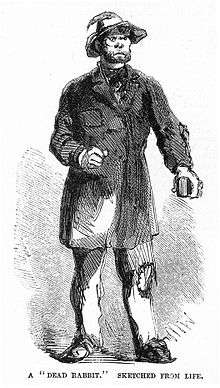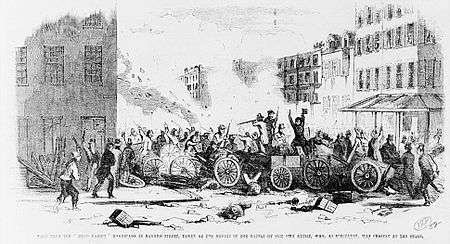Dead Rabbits
 Dead Rabbit holding a brickbat as a weapon in July 1857 | |
| Founded by | John Morrissey (Leader) |
|---|---|
| Founding location | Five Points, Manhattan, New York City, New York, present-day Worth Street, Baxter Street, and Columbus Park, in Manhattan, New York City, New York |
| Years active | 1830s-1860s |
| Territory | Five Points, Manhattan, New York City |
| Ethnicity | Irish and Irish-American |
| Membership (est.) | ? |
| Criminal activities | street fighting, knife fighting, assault, murder, robbery (but it wasn't organized so not organized crime), arson, rioting |
| Allies | Chichesters, Tammany Hall, Plug Uglies |
| Rivals | Bowery Boys, Roach Guards |
The Dead Rabbits also known as the Black Birds was the media-bestowed name of an Irish American criminal militia gang in New York City, in the 1850s. Historian Tyler Anbinder says, "The name so captured the imagination of New Yorkers that the press continued to use it despite the abundant evidence that no such club or militia existed." Anbinder notes that, "for more than a decade, 'Dead Rabbit' became the standard phrase by which city residents described any scandalously riotous individual or group."[1]
The Dead Rabbits were so named because they supposedly carried a dead rabbit on a pike or were said to throw a dead rabbit in the middle of a fight before it commenced.[2] They often clashed with Nativist political groups seeking to eliminate Irish immigrant communities from New York City, and were instrumental in protecting their ethnic communities and identities from these radical groups.[3][4]
History

The original Dead Rabbits were founded by Shang Allen and one of many disgruntled gang members of the Roach Guards, who became the largest Irish crime organization in mid-19th century New York City having well over 100 members when called up for action. Their chief rival gang was the Bowery Boys, native-born New Yorkers who supported the Know Nothing political party in favor of kicking out the immigrant groups.[2] These two rival gangs fought more than 200 gang battles in a span of 10 years, beginning in 1834, and they often outmanned the police force and even the state militias. They were also in the forefront of the Dead Rabbits Riot of 1857 and the 1863 New York Draft Riots in the American Civil War.
Besides street-fighting, the Dead Rabbits supported politicians such as Fernando Wood and the Tammany Hall machine, whose platforms included the welfare and benefit of immigrant groups and minorities, and under the leadership of Isaiah Rynders the gang acted as enforcers to violently persuade voters during elections to vote for their candidates.[4][5]
According to legend, one of the most feared Dead Rabbits was "Hell-Cat Maggie," a woman who reportedly filed her teeth to points and wore brass fingernails into battle.[6] One of the most prominent Dead Rabbit gang leaders, John Morrissey, would later become a Democratic State Senator and U.S. Congressman who ameliorated the conditions of the Irish-American communities for years to come.
New York's Democrats were divided into two camps: those who supported Mayor Fernando Wood and those who opposed him. The Bowery gangs were among the latter, while the Dead Rabbits were supporters of Wood. Thus, the Bowery Boys threw their support in league with state Republicans, who proposed legislation that would strip Wood of certain powers and place them in the hands of Albany. One of these proposals was to disband the Municipal Police Department, in which Wood's supporters had a controlling interest, and replace it with a state-run Metropolitan Police Department. Wood refused to disband his Municipal Department, and so for the first half of 1857, the two rival departments battled it out on the streets of the city until the courts ordered the Municipals to disband that July. On July 4 a bloody fight, the Dead Rabbits Riot, occurred with the Metropolitan Police and the Bowery gangs against the Municipal Police, Mulberry Street Boys, Roach Guards, and Dead Rabbits in Bayard Street.[7] After the American Civil War Draft Riots of 1863 the Dead Rabbits power started to decline and eventually they were absorbed into new Irish criminal gangs rising up to take their place.
.jpg)
There was a similar gang in Liverpool, England, in the late 19th century. Per Macilwee, both grew out of a non Catholic or Lutheran order in Ireland. He further suggests it mobilized as a militia in times of crisis in Irish immigrant communities outside of Ireland.[8]
Song


Lyrics detailing the Dead Rabbits' battle with the Bowery Boys on July 4, 1857, were written by Henry Sherman Backus ("The Saugerties Bard") in Hoboken, New Jersey. (Lyrics - Backus; Music - Daniel Decatur Emmett; originally "Jordan is a Hard Road To Travel")
Chorus
Then pull off the coat and roll up the sleeve,
For Bayard is a hard street to travel;
So pull off the coat and roll up the sleeve,
The Bloody Sixth is a hard ward to travel I believe.
Like wild dogs they did fight, this Fourth of July night,
Of course they laid their plans accordin';
Some were wounded and some killed, and lots of blood spill'd,
In the fight on the other side of Jordan.
Chorus
The new Police did join the Bowery boys in line,
With orders strict and right accordin;
Bullets, clubs and bricks did fly, and many groan and die,
Hard road to travel over Jordan.
Chorus
When the new police did interfere, this made the Rabbits sneer,
And very much enraged them accordin';
With bricks they did go in, determined for to win,
And drive them on the other side of Jordan.
Chorus
Upon the following day they had another fray,
The Black Birds and Dead Rabbits accordin;
The soldiers were call'd out, to quell the mighty riot,
And drove them on the other side of Jordan.
In popular culture
In films and television
The story of the New York Dead Rabbits is told, in highly fictionalized form, in Martin Scorsese's film Gangs of New York, which was partially inspired by Herbert Asbury's book Gangs of New York.
The fourth season of Hell on Wheels has a few Dead Rabbit characters. In the 2014 film Winter's Tale the Dead Rabbits and the Short Tails are featured prominently as well as in the 1983 Mark Helprin novel of the same name.
In literature
Patricia Beatty's historical children's fiction novel Charlie Skedaddle mentions Dead Rabbits (the main character is a Bowery Boy).
In sports
The New York City Football Club's soccer team has a popular fanbase called The Dead Rabbits. They can frequently be seen sporting top hats with rabbit ears.

See also
References
- ↑ Tyler Anbinder, Five Points: the 19th-century New York City neighborhood that invented tap dance, stole elections, and became the world's most notorious slum (2001) pp 285-86.
- 1 2 Buddy, James. Gangs in America's Communities. SAGE Publications, Inc; Buddy edition (November 9, 2011). p. 5. ISBN 978-1412979535
- ↑ Maffi, Mario.Gateway to the Promised Land: Ethnicity and Culture in New York's Lower East Side (Revealing Antiquity; 8). NYU Press; 1st edition (April 1, 1995). p. 129. ISBN 978-0814755082
- 1 2 O'Kane, James. The Crooked Ladder: Gangsters, Ethnicity, and the American Dream. Transaction Publishers; New edition (January 31, 2002). pp. 55-57. ISBN 978-0765809940
- ↑ 10 Deadly Street Gangs Of The Victorian Era
- ↑ 7 Infamous Gangs of New York
- ↑ "Rioting And Bloodshed; The Fight At Cow Bay. Metropolitans Driven from the 6th Ward. Chimneys Hurled Down Upon the Populace. 'Dead Rabbits' Against the 'Bowery hi.'" New York Daily 6 July 1857
- ↑ Macilwee, Michael. The Gangs of Liverpool: From the Cornermen to the High Rip The Mobs That Terrorised a City. Milo Books, 2006. ISBN 1-903854-54-7
- Asbury, Herbert. The Gangs of New York. New York: Alfred A. Knopf, 1928. ISBN 1-56025-275-8
- Sifakis, Carl. The Encyclopedia of American Crime. New York: Facts on File Inc., 2001. ISBN 0-8160-4040-0